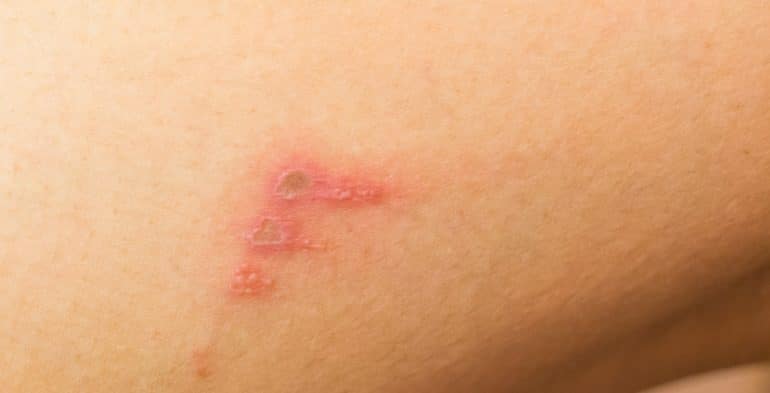
What is Impetigo in children?
This is a common and highly contagious skin infection that causes sores and blisters. It’s not usually serious and often improves within a week of treatment or within a few weeks without treatment.
Symptoms
There are two types of impetigo:
Non-bullous impetigo – the most common type
Bullous impetigo
The symptoms of both types are described here.
Non-bullous impetigo
The symptoms of non-bullous impetigo begin with the appearance of red sores – usually around the nose and mouth but other areas of the face and the limbs can also be affected.
The sores quickly burst leaving behind thick, golden crusts typically around 2cm across. The appearance of these crusts is sometimes likened to cornflakes stuck to the skin.
After the crusts dry, they leave a red mark that usually fades without scarring. The time it takes for the redness to disappear can vary between a few days and a few weeks.
The sores aren’t painful, but they may be itchy. It’s important not to touch or scratch the sores because this can spread the infection to other parts of the body, and to other people.
Other symptoms, such as a high temperature (fever) and swollen glands are rare but can occur in more severe cases.
Bullous impetigo
The symptoms of bullous impetigo begin with the appearance of fluid-filled blisters (bullae) which usually occur on the central part of the body between the waist and neck, or on the arms and legs. The blisters are usually about 1-2cm across.
They may quickly spread, before bursting after several days to leave a yellow crust that usually heals without leaving any scarring.
They may also be painful and the area of skin surrounding them may be itchy. As with non-bullous impetigo, it’s important not to touch or scratch the affected areas of the skin.
Symptoms of fever and swollen glands are more common in cases of bullous impetigo.
When to seek medical advice
Speak to your doctor if you think you or your child may have symptoms of impetigo.
Impetigo isn’t usually serious, but it can sometimes have similar symptoms to more serious conditions such as cellulitis (an infection of the deeper layers of skin) so it’s important to get a correct diagnosis.
Your doctor can also prescribe treatment to help clear up the infection more quickly than if it was left untreated.
Causes of impetigo
This illness occurs when the skin becomes infected with bacteria, which occurs in one of two ways; they enter through a break in otherwise healthy skin such as an insect bite or cut or other injury; this is known as primary impetigo, or through skin damaged by another underlying condition, such as head lice, scabies or eczema – this is known as secondary impetigo
The bacteria can be spread easily through close contact with someone who has the infection, such as through direct physical contact, or by sharing towels or flannels.
As the condition doesn’t cause any symptoms until four to 10 days after initial exposure to the bacteria, it’s often easily spread to others unintentionally.
Children and people with diabetes or a weakened immune system are most at risk of developing impetigo.
Treating impetigo
Impetigo usually gets better without treatment in around two to three weeks.
However, treatment is often recommended because it can reduce the length of the illness to around seven to 10 days and can lower the risk of the infection being spread to others.
The main treatments prescribed are antibiotic creams or antibiotic tablets. These usually have to be used for around a week.
Preventing the spread of impetigo
During treatment, it’s important to take precautions to minimise the risk of impetigo spreading to other people or to other areas of the body.
Most people are no longer contagious after 48 hours of treatment or once their sores have dried and healed. It’s important to stay away from work, school, nursery or playgroup until this point.
The advice below can also help to prevent the spread of the infection:
- don’t share flannels, sheets or towels with anyone who has impetigo – wash them at a high temperature after use
- wash the sores with soap and water and cover them loosely with a gauze bandage or clothing
- avoid touching or scratching the sores, or letting others touch them – it may help to ensure your nails are kept clean and short
- avoid contact with newborn babies, preparing food, playing contact sports, or going to the gym – until the risk of infection has passed
- wash your hands frequently – particularly after touching infected skin
- washable toys should also be washed – wipe non-washable soft toys thoroughly with a cloth that has been wrung out in detergent and warm water and allowed to dry completely
If you think that the infection has spread to someone else, make sure they’re seen by a GP as soon as possible.
Preventing recurrent impetigo
To reduce the risk of impetigo returning, make sure any cuts, scratches or bites are kept clean. Ensure any condition that causes broken skin, such as eczema, is treated promptly.
If your child develops this condition frequently, your doctor may suggest taking a swab from around your child’s nose to see if they carry staphylococcal bacteria. These bacteria can live in the noses of some people without causing problems, although they can lead to impetigo if they infect broken skin nearby.
If your child is found to carry these bacteria, they may be prescribed an antiseptic nasal cream to apply several times a day for five to 10 days in an attempt to clear the bacteria and reduce the chances of it recurring.
Complications of impetigo
Complications are rare, but they can sometimes occur and can be serious. Tell your doctor if your child has it and their symptoms change or get worse.
Some complications associated with this illness include:
- cellulitis – an infection of the deeper layers of the skin and underlying tissue
- scarlet fever – a rare bacterial infection that causes a fine, pink rash across the body
- Staphylococcal scalded skin syndrome (SSSS) – a serious skin condition that looks like the skin has been scalded with boiling water
- In very rare cases, impetigo may lead to some scarring, particularly if your child scratches at the blisters, crusts or sores.







